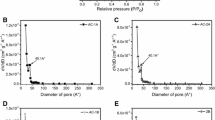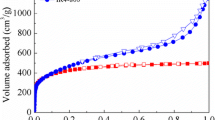Abstract
Much controversy exists about the mechanism by which gold cyanide adsorbs on activated carbon. It is not the purpose of this article to explain the exact adsorption mechanism but, rather, to investigate the factors affecting the reversibility of adsorbed gold cyanide. Whereas Au(CN) −2 is soluble in water, AuCN and Au require the addition of cyanide to form Au(CN) −2 . The reversibility of the adsorption of gold onto carbon is a function of the nature of the adsorbed gold and determines the need for cyanide in the elution process, which affects the operating costs of a carbon-in-pulp (CIP) plant. The fraction of adsorbed Au(CN) −2 that will be decomposed to AuCN was found to be a function of the pH and temperature of the solution and the type of activated carbon used. It was observed that two different batches of carbon from the same manufacturer yielded widely different ratios of AuCN to Au(CN) −2 , although their specifications did not differ much. These results were confirmed by Fourier transform infrared spectroscopy (FTIR) and X-ray photoelectron spectroscopy (XPS). A combination of low pH and high temperature, as is found in the hot acid wash step of an AARL elution, leads to the reduction of both Au(1) species to metallic gold, Au(0). The fraction of the adsorbed Au(CN) −2 that is converted to AuCN or Au(0) no longer participates in the equilibrium between Au(CN) −2 in solution and Au(CN) −2 in the adsorbed phase. It was observed that the isotherm for desorption is higher than the isotherm for adsorption by a percentage which is, on average, equal to the percentage of Au(CN) −2 converted to AuCN or Au(0).
Similar content being viewed by others
References
R.J. Davidson:J.S. Afr. Inst. Min. Metall., 1974, vol. 75 (4), pp. 67–76.
G.J. McDougall, M.D. Adams, and R.D. Hancock:Hydrometallurgy, 1987, vol. 18, pp. 125–38.
M.D. Adams, G.J. McDougall, and R.D. Hancock:Hydrometallurgy, 1987, vol. 18, pp. 139–54.
M.D. Adams, G.J. McDougall, and R.D. Hancock:Hydrometallurgy, 1987, vol. 19, pp. 95–115.
G.J. McDougall, R.D. Hancock, M.J. Nicol, O.L. Wellington, and R.G. Copperthwaite:J.S. Afr. Inst. Min. Metall., 1980, vol. 80 (9), pp. 344–56.
N. Tsuchida and D.M. Muir:Metall. Trans. B, 1986, vol. 17B, pp. 529–33.
R. Cook, E.A. Crathome, A.J. Monhemius, and D.L. Perry:Hydrometallurgy, 1989, vol. 22, pp. 171–82.
W. Jones, C. Klauber, and H.G. Linge:Randol Conf. on Gold and Silver, Perth, Australia, 1988, Randol International, Golden, CO, pp. 243–48.
J.D. Cashion, A.C. McGrath, P. Volz, and J.S. Hall:Trans. Instn. Min. Metall. (Sect. C: Mineral Process. Extr. Metall.), 1988, vol. 97, pp. 129–33.
M.D. Adams and C.A. Fleming:Metall. Trans. B, 1989, vol. 20B, pp. 315–25.
A.S. Ibrado and D.W. Fuerstenau:Hydrometallurgy, 1992, vol. 30, pp. 243–56.
C. Klauber and C.F. Vernon:Hydrometallurgy, 1990, vol. 25, pp. 387–96.
R. Cook, E.A. Crathorne, A.J. Monhemius, and D.L. Perry:Hydrometallurgy, 1990, vol. 25, pp. 387–96.
J.W. Hassler:Purification with Activated Carbon, Chemical Publishing Co., Inc., New York, NY, 1974, p. 330.
J.S.J. Van Deventer:Proc. MINTEK 50: Int. Conf. on Mineral Science and Technology, L.F. Haughton, ed., MINTEK, Randburg, South Africa, 1985, vol. 2, pp. 487–94.
Handbook of Chemistry and Physics, 64th ed., CRC Press, Inc., Boca Raton, FL, 1985, p. B-95.
H.C. Hughes and H.G. Linge:Hydrometallurgy, 1989, vol. 22, pp. 57–65.
D.M. Adams:Metal-ligand and related vibrations, Edward Arnold (Publishers) Ltd., London, 1967, pp. 164 and 172.
P.F.der Merwe: Ph.D. Thesis, University of Stellenbosch, Stellenbosch, South Africa, 1991, p. 453.
M.D. Adams:Hydrometallurgy, 1990, vol. 25, pp. 171–84.
P.F. Van der Merwe and J.S.J. Van Deventer:Chem. Eng. Commun., 1988, vol. 65, pp. 121–38.
M.D. Adams:Hydrometallurgy, 1992, vol. 31, pp. 111–20.
L.M. Davey: Paper Presented at11th Mineral Processing Symp., South African Institute of Mining and Metallurgy, Gordon’ss Bay, South Africa, August, 1992.
Author information
Authors and Affiliations
Rights and permissions
About this article
Cite this article
Van Deventer, J.S.J., Van Der Merwe, P.F. The reversibility of adsorption of gold cyanide on activated carbon. Metall Trans B 24, 433–440 (1993). https://doi.org/10.1007/BF02666425
Received:
Published:
Issue Date:
DOI: https://doi.org/10.1007/BF02666425




